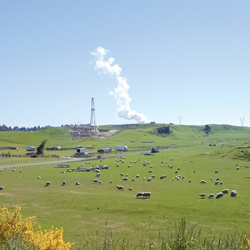The goal of all oil and gas production is to produce fuel that can be converted to heat. Petroleum is just potential energy in a very convenient, usable form. Except when electricity is produced directly for immediate use, such as with hydroelectric or solar, all useful energy exists, at some point, in the form of steam, before it is converted to work. Under certain conditions, it is possible to skip the middle man completely and just drill for steam.
 |
A geothermal drilling rig operating near Lake Taupo, New Zealand. Photo credit: Wikimedia Commons.
|
|
The Earth’s interior is hot, brought on by billions of years of radioactive decay. At various points on the planet’s crust, rainwater seeps down, close enough to very hot subterranean places to emerge, sometimes thousands of years later, as hot water and steam. Indigenous people have taken advantage of these naturally hot waters since prehistoric times, such as at Bath in England or the hot springs in Arkansas, for bathing and medicinal uses. (Of course, it often didn’t take long for some entrepreneurs to rope the places off and demand remuneration for soaking privileges.)
The first commercial use of geothermal water for heating was in Boise, Idaho, where water from hot springs was captured and piped to local homes and businesses, beginning in the 1890s. The system is still used today to heat the core areas of the city, and remains the largest direct-use geothermal system in the country. In 1904, the first geothermal, steam-driven, electric power plant was constructed in Larderello, on the northwestern coast of Italy, an area known for phreatic (steam) volcanic eruptions.
Moving away from the geysers. One thing that the aforementioned sites have in common is geological proximity to natural geysers and steam vents. Most commercial geothermal plants take advantage of existing superheated water, which is tapped and released, as opposed to pumping water down. This limits the regions where geothermal power plants can be built.
However, subterranean heat is literally everywhere on the planet. Drill deep enough anywhere, and you hit temperatures that can turn water into usable steam. Throughout the 20th century, there were various attempts to build systems based on this concept, known as hot dry rock (HDR) systems. Later, they were renamed “enhanced geothermal systems” (EGS).
An exhaustive study, called The Future of Geothermal Energy (2006), was conducted by the Massachusetts Institute of Technology, with the stated goal of figuring out what it would take for EGS to provide 100,000 MW of capacity by 2050. They concluded that, while there are many barriers to commercial EGS development, technology was not one of them.
A conventional geothermal well costs about $5 million to drill and complete. In the past, at least half of these proved non-commercial. Thanks to advances in oil and gas drilling, and specifically developments in hydraulic fracturing and fluid flow, it is feasible to circulate water at depths of 3 to 5 km through large volumes of fractured, porous rock and return it to the surface as steam with sufficient pressure to drive turbines, and do so at “near-commercial” rates. Compared to drilling new wells, re-entering and fracturing older, less-efficient ones holds great economic promise. A recent project in Desert Peak, Nev., saw hydraulic fracturing increase the productivity of a geothermal field by 38%. One company, AltaRock Energy, has announced plans to buy up existing, unsuccessful geothermal fields, and use EGS technology to try and make them profitable again.
In the U.S., geothermal power is a miniscule fraction of the energy mix. Although we have the largest installed capacity of geothermal power plants in the world—roughly 3.4 gigawatts—it is still less than 0.5% of the total. Worldwide, a small number of countries that sit on top of active seismic belts, such as Iceland and New Zealand, use geothermal power as a large share of the total. Making the hot dry rocks pay in other places will take substantial investment, either public or private, or both.
The U.S. has spent close to $150 billion on renewable energy since 2009, in tax credits and grants. EGS’s share has been tiny—barely $45 million in 2014. The MIT study estimated that $1 billion spent over 15 years would be sufficient to raise EGS production to the 2050 target of 100 MW. The capital costs of building an EGS plant are high, but the “fuel” is virtually free and maintenance is cheap, so that, in the end, a geothermal plant can produce electricity in the range of 5 cents/kWh, similar to a coal plant, but with near-zero emissions.
Geothermal plants can be “base-load” systems that can run 24-7-365, but they also can operate as “peak-load” systems, providing power on demand, unlike nuclear systems, which have to operate at full capacity. Unlike wind or solar systems, they can ramp-up at any time.
What’s not to like? So far, the EGS industry has been too small to make enemies. Environmental groups are conflicted, because while there is potential for a network of green, non-polluting, small-footprint, essentially limitless power sources, the very fact that EGS involves the “F word” (fracing) causes many to be on edge. And although the issues of groundwater pollution, earthquakes and such are all considered manageable by experts, the potential of a major fight over EGS has investors nervous as well. My advice? Move slowly, and be very careful what you call it. 
|



